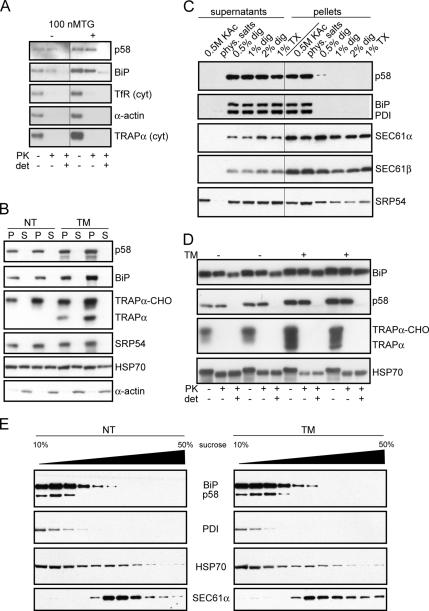Figure 3.
Endogenous p58IPK is a component of the ER lumen. (A) Postnuclear hypotonic lysates from NIH 3T3 cells were treated with PK in the presence or absence of Triton X-100 (det) and probed by immunoblot against the indicated proteins. Antibodies against the transmembrane proteins TRAPα and TfR were directed against cytosolic epitopes. Note that BiP contains a protease-resistant core that is not digested fully even in the presence of detergent. (B) Postmitochondrial supernatants from homogenized livers of untreated or TM-injected mice (16 h) were sedimented over a cushion of 0.8 M sucrose. The microsomal pellets (P) and cytosolic supernatants (S) were probed by immunoblot against the indicated proteins. Efficacy of the TM was reflected in inhibition of TRAPα glycosylation and increased expression of p58IPK and BiP, which are both up-regulated by ER stress. (C) Canine pancreatic microsomes were extracted using high salt, physiological salt, or varying concentrations of digitonin (dig) or Triton X-100 (TX). Microsomes were then separated by centrifugation into extracted (supernatants) and nonextracted (pellets) fractions, followed by immunoblot as indicated. (D) Murine liver microsomes prepared as described in B were treated with PK in the presence or absence of detergent (1% digitonin) and analyzed by immunoblot against the indicated proteins to assess their respective topologies. Note the complete protection from PK digestion of both BiP and p58IPK in the absence of detergent. By contrast, TRAPα (detected using an antibody against its cytosolic tail) and HSP70 are equally accessible in the absence or presence of detergent. Note that both BiP and HSP70 contain protease-resistant cores that are not digested fully even in the presence of detergent. (E) Murine liver microsomes from either nontreated or TM-treated mice were solubilized in a physiological salt buffer containing 1% digitonin. The samples were separated by velocity sedimentation through a continuous sucrose gradient and individual fractions probed by immunoblot against the indicated proteins.

